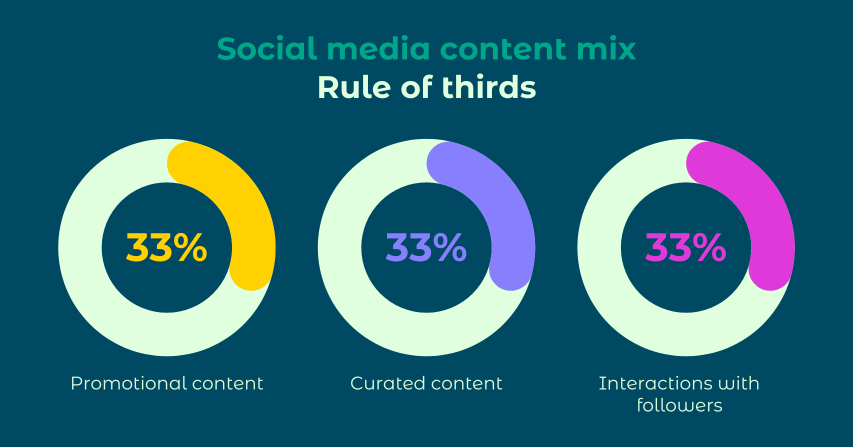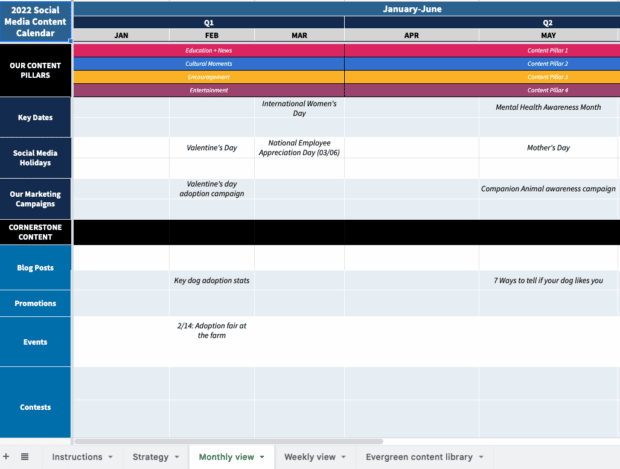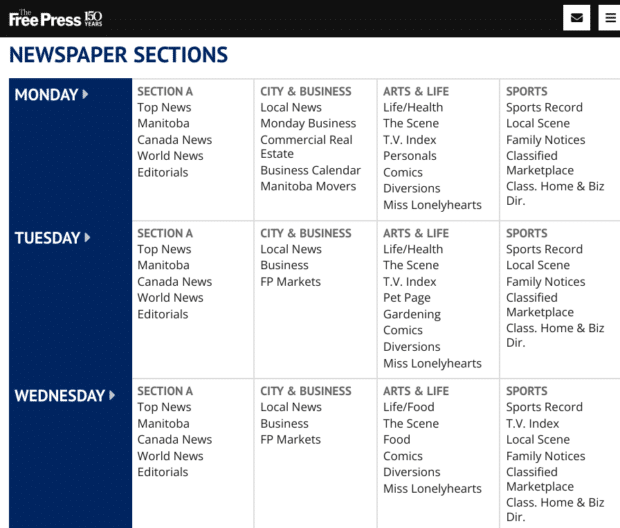
Social media content calendars are the best way to plan and organize your content. Build one in 4 easy steps or use our free templates.
Christina Newberry July 26, 2024 10 min read
We know, planning is not everyone’s favorite — but sometimes, putting a little bit of work into building a plan saves you a whole lot of work down the line. A social media calendar is the perfect example. It helps you organize your work, plan your content ahead and keep an always up-to-date bird’s-eye view of your social strategy.
Keep reading for your complete guide to setting up a practical and powerful, easy-to-use social media calendar. We’ve even included some free social media calendar templates to get you started!
Bonus: Download our free, customizable social media calendar template to easily plan and schedule all your content in advance.
A social media calendar is a detailed overview of your upcoming social media posts, organized by date and time. It can take the form of a document, spreadsheet, or interactive dashboard.
Social marketers use content calendars to plan posts, manage campaigns, and review ongoing strategies.
Every entry in a social media calendar typically includes some combination of these elements:

Create. Schedule. Publish. Engage. Measure. Win.
Follow the steps below to create a lean and efficient social media content plan.
Before building your social media posting calendar, you need a clear picture of your existing social media accounts.
Use our free social media audit template to create a precise, up-to-date record of:
As part of your audit, note how often you’re currently posting on each social network. Look at your analytics for any clues about how your posting frequency or time of posting impacts engagement and conversions.
Hot tip: Sign up for a 30-day free Hootsuite trial, and use our all-in-one analytics dashboard to easily analyze your performance and track competitors in one spot.

Deciding what kinds of content to post is a key part of your social media strategy — and an important step to building a social media calendar. There are a couple of standard marketing strategies for content mix that you can use to get started:

You’ll also need to determine which social channels to use for which types of content. Some may not be necessary at all. The audit you completed in step 1 will help you determine which channels are the best fit for your business.
Don’t forget to schedule user-generated content and curated content. That way, you don’t get too bogged down with hands-on content creation.
Regardless of your strategy for sourcing content, remember to stay focused on who you’re trying to reach. Eileen Kwok, Hootsuite’s Social Marketing Specialist says:
Always put your target audience first. Instead of chasing views and engagements, prioritize content your followers will value.
And remember: you can’t plan everything. Room for flexibility is a crucial element of your calendar:
Leave room for pop culture moments and be ready to shuffle content around. Plus, don’t post during major crises—sometimes you have to sit back and let social media do its thing.
Your social media calendar won’t look exactly like anyone else’s. For example, a small business owner doing their own social posts will likely have a much simpler calendar than a large brand with a full social team.
Map out the information and functions that are most important to you. That way, you can get the most out of your social calendar.
Start with basic details, like:
You may also want to add more advanced info, like:
If you’re just getting started, a simple spreadsheet works well. If you’re looking for a more powerful solution, consider a social media management tool like Hootsuite. Hootsuite comes with an interactive calendar that:

An effective social calendar makes sense to everyone on your marketing team. Ask for feedback and ideas from stakeholders and your team to make sure it serves everyone’s needs.
As you start to work with your calendar, evaluate how it feels to you, and ask the team to provide ongoing feedback. For example, if it feels onerous and finicky, maybe you want to dial back some of the detail. If it’s not detailed enough, you may need to add a few columns.
Your calendar will probably continue to evolve as your business does — and that’s okay!
We’ve created two free social media content calendar templates for you to use as a basis for your own calendar. Just open the Google Sheets link, make a copy, and plan away.
The social media content calendar template linked above has room for the major platforms (Facebook, Instagram, Twitter, LinkedIn and TikTok). But it’s highly customizable, and you’re free to make it your own with the channels that make sense for you.

Make sure to create a new tab for each month, and plan out your editorial content week by week.
Among the many helpful items in this calendar, don’t miss the tab for evergreen content. This is where you can keep track of blog posts or other content that always performs well on social, despite seasonality.
This template includes columns for you to track and schedule:
Use the editorial calendar template linked above to plan individual content assets. Think blog posts, videos, new research, etc. This is where you plan out the content that your social media efforts will be promoting.
The template is easy to use. Just create a new tab for each month, and plan your editorial content out week by week.
This social media editorial calendar template includes the following columns:
You may want to adapt your template to include other important information, like target keyword or content bucket.
A social media calendar lets you plan ahead, batch your work, avoid multitasking, and note down all your content ideas for later.
Social media planning calendar tools even allow you to schedule social media posts ahead of time. That means your accounts can be active every day without you having to log into all your social platforms every hour on the hour.
The average internet user regularly uses 7.5 social media platforms. For marketers managing multiple social media accounts, the number can be much higher. When you’re managing multiple accounts, getting organized is essential — and planning your content frees up time for more strategic work, which is often more fun anyway.
There is no hard and fast rule about how often you should post on social media. That said, there are some generally accepted best practices to use as a baseline. The most important rule, no matter how often you decide to post, is to post on a consistent schedule.
Sticking to a regular schedule is important, so your followers and fans know what to expect. It’s also a good way to make clever use of weekly hashtags like #MondayMotivation. (I prefer #MonsteraMonday, but that might not be for everyone.)
For a real-world example, take a look at the weekly content calendar for The Winnipeg Free Press. Sure, this isn’t a social media content calendar, but it is a weekly plan anchored by consistent content ideas.
 topics to cover across several verticals and categories." width="620" height="528" />
topics to cover across several verticals and categories." width="620" height="528" />
Content frameworks like these give you one less thing to consider as you create your posts. Scheduling posts in advance allows you to stick to a schedule while ensuring you always have quality content ready to go.
Social media calendar tools also allow you to post at the best times for your audience, even if those times don’t align with your core working hours. Which leads us to…
When you create content and schedule it in advance, you can actually take time off. No logging into your work accounts on Thanksgiving, late at night, or early in the morning.
For busy social media managers, creating a social media calendar is an act of self-care.
Planning posts ahead of time allows you to check your work and build a safety net into your workflow. Everything’s easier when you’re not rushing to post.
A social media calendar — especially one with an approval process — is the best way to prevent everything from minor mistakes to social media crises.
Social media production values have skyrocketed since the early days. Today, it’s not unusual for a single post to have a whole social media team of creatives behind it.
Asking your team to drop everything for an emergency Instagram Reel won’t win hearts or minds. It’s not going to result in your best possible content or a cohesive account either.
A social media calendar helps you distribute resources and make sure your team has the breathing room to do their best work.
Following a long-term plan also allows you to craft content that supports your social media marketing goals and beyond.
Planning your content in a calendar forces you to keep an eye on what’s happening in, well, the calendar. This means you’re prepared for everything from Daylight Savings Time to the Super Bowl. (And everything else: We’re looking at you, National Pizza Day.)
We’ve created a Google Calendar of holidays you can use to frame social media posts. You can import it into your own Google Calendar to give your content planning a little extra relevance.